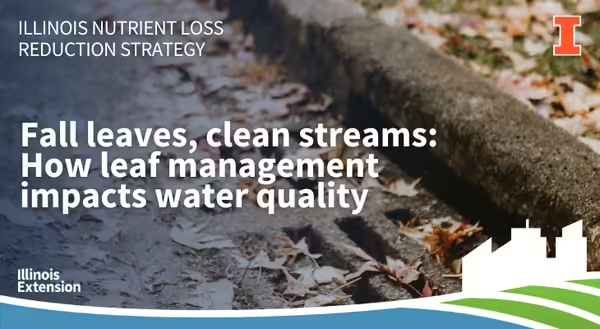
Episode 57 of the Illinois Nutrient Loss Reduction Strategy podcast discusses an often-overlooked aspect of maintaining water quality – the impact of fall leaf management. In this episode, University of Illinois Extension's Eliana Brown, a water quality and stormwater specialist, and Chris Enroth, a horticulture educator, reveal how the management of fall leaves have an influence on water quality in Illinois and ecosystems in your yard.
Fall leaves and nutrient loss
Eliana begins by explaining how fall leaves are a significant source of phosphorus in urban stormwater systems. She references a comprehensive USGS study from Wisconsin, which uncovered that nearly 60% of the annual phosphorus in urban systems can be attributed to fall leaves. She explains that in natural settings, tree leaves enrich the soil with nutrients, creating a cycle of nourishment that sustains the trees. However, in urban areas, this cycle is disrupted as leaves are transported from where they fell to a local storm drain. These channels feed directly into lakes and rivers without any treatment. As a result, the nutrients that should nourish the soil end up in the water, which can cause local water quality issues.
Chris emphasizes the significance of urban tree management in reducing nutrient loss. He explains that a healthy urban canopy of trees can intercept rainfall, slowing it down and allowing stormwater infrastructure more time to handle water. This reduces flash floods and minimizes the movement of pollutants like sediment and nutrients from home lawns or properties.
Sustainable leaf management
How can we mitigate this impact? Eliana and Chris explain that sustainable leaf management is critical. Removing leaves from the streets can allow us to use their nutrients to our advantage. The USGS study found that timely leaf litter removal can reduce phosphorus concentrations in stormwater by over 80%. It's important to maintain clean streets before rainfall to reduce nutrient concentrations.
In addition to sustainable leaf management, Eliana reveals that homeowners can also reduce nutrient loss through sustainable lawn care, minimizing hard surfaces, and capturing rainwater through practices like rain gardens.
What can homeowners do?
It is crucial to manage fall leaves responsibly. This can be accomplished by keeping leaves in your yard rather than the streets, as this introduces organic matter filled with nutrients into stormwater systems, ultimately affecting the health of lakes, streams, and rivers. Homeowners can utilize their leaves on-site, potentially turning them into compost or mulch for lawns and gardens. Moreover, these leaves can provide shelter for overwintering insects and nesting material for birds in the spring. By understanding and implementing sustainable leaf management practices, homeowners can make a positive impact on water quality and the environment.
To listen to the complete interview with Eliana and Chris, be sure to check out the Illinois Nutrient Loss Reduction Podcast episode 57.
About the authors
Rachel Curry is an Agriculture and Agribusiness Educator focusing on agriculture and watershed education and is a part of the Illinois Extension's Nutrient Loss Reduction Strategy implementation team. Rachel earned a B.A. in Environmental Studies from Knox College and an M.S. in Environmental Science and Soil Science from Iowa State University with an emphasis on soil fertility. Her work focuses on education and outreach regarding the Illinois Nutrient Loss Reduction Strategy and agricultural conservation practices to reduce nutrient loss and improve water quality and soil health throughout Illinois.
Nicole Haverback is a Watershed Outreach Associate and is a part of the Illinois Extension's Nutrient Loss Reduction Strategy implementation team. Nicole earned a BS in Agriculture and Rural Policy Studies from Iowa State University. She coordinates watershed and planning activities to reduce nutrient losses from priority watersheds, provides expertise on best management practices for nutrient loss, and conducts outreach on agricultural conservation practices outlined in the Illinois Nutrient Loss Reduction Strategy.
About the blog
At Illinois Extension, we’re working to improve water quality at home and downstream. Every month, our Watershed Outreach Associates will bring you stories highlighting agricultural conservation practices, current research projects and results, and from the field farmer interviews. The Nutrient Loss Reduction blog covers conservation practices recommended by the Illinois Nutrient Loss Reduction Strategy, timely updates, farm safety, and new decision tools to help farmers and producers reduce the nutrients leaving their field. Want to get notified when new blog posts are available? Subscribe at go.illinois.edu/SubscribeINLRS.